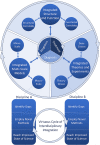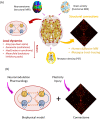Mechanisms Underlying Disorders of Consciousness: Bridging Gaps to Move Toward an Integrated Translational Science
- PMID: 34236622
- PMCID: PMC8266690
- DOI: 10.1007/s12028-021-01281-6
Mechanisms Underlying Disorders of Consciousness: Bridging Gaps to Move Toward an Integrated Translational Science
Erratum in
-
Correction: Mechanisms Underlying Disorders of Consciousness: Bridging Gaps to Move Toward an Integrated Translational Science.Neurocrit Care. 2022 Jun;36(3):1080. doi: 10.1007/s12028-022-01488-1. Neurocrit Care. 2022. PMID: 35359223 Free PMC article. No abstract available.
Abstract
Aim: In order to successfully detect, classify, prognosticate, and develop targeted therapies for patients with disorders of consciousness (DOC), it is crucial to improve our mechanistic understanding of how severe brain injuries result in these disorders.
Methods: To address this need, the Curing Coma Campaign convened a Mechanisms Sub-Group of the Coma Science Work Group (CSWG), aiming to identify the most pressing knowledge gaps and the most promising approaches to bridge them.
Results: We identified a key conceptual gap in the need to differentiate the neural mechanisms of consciousness per se, from those underpinning connectedness to the environment and behavioral responsiveness. Further, we characterised three fundamental gaps in DOC research: (1) a lack of mechanistic integration between structural brain damage and abnormal brain function in DOC; (2) a lack of translational bridges between micro- and macro-scale neural phenomena; and (3) an incomplete exploration of possible synergies between data-driven and theory-driven approaches.
Conclusion: In this white paper, we discuss research priorities that would enable us to begin to close these knowledge gaps. We propose that a fundamental step towards this goal will be to combine translational, multi-scale, and multimodal data, with new biomarkers, theory-driven approaches, and computational models, to produce an integrated account of neural mechanisms in DOC. Importantly, we envision that reciprocal interaction between domains will establish a "virtuous cycle," leading towards a critical vantage point of integrated knowledge that will enable the advancement of the scientific understanding of DOC and consequently, an improvement of clinical practice.
Keywords: Brain injury; Coma; Consciousness; Electroencephalography; Magnetic resonance imaging; Mechanism; Neuroimaging.
Conflict of interest statement
The authors declare no conflicts of interest.
Figures





References
-
- Owen AM, Coleman MR, Boly M, Davis MH, Laureys S, Pickard JD. Detecting awareness in the vegetative state. Science. 2006;313:1402. - PubMed
-
- Monti MM, Vanhaudenhuyse A, Coleman MR, Boly M, Pickard JD, Tshibanda L, et al. Willful modulation of brain activity in disorders of consciousness. N Engl J Med. 2010;362:579–589. - PubMed
-
- Naci L, Sinai L, Owen AM. Detecting and interpreting conscious experiences in behaviorally non-responsive patients. Neuroimage. 2017;145:304–313. - PubMed
-
- Claassen J, Doyle K, Matory A, Couch C, Burger KM, Velazquez A, et al. Detection of brain activation in unresponsive patients with acute brain injury. N Engl J Med. 2019;380:2497–2505. - PubMed
-
- Casali AG, Gosseries O, Rosanova M, Boly M, Sarasso S, Casali KR, et al. A theoretically based index of consciousness independent of sensory processing and behavior. Sci Transl Med. 2013;5:198ra105. - PubMed
Publication types
MeSH terms
Grants and funding
LinkOut - more resources
Full Text Sources
Miscellaneous

